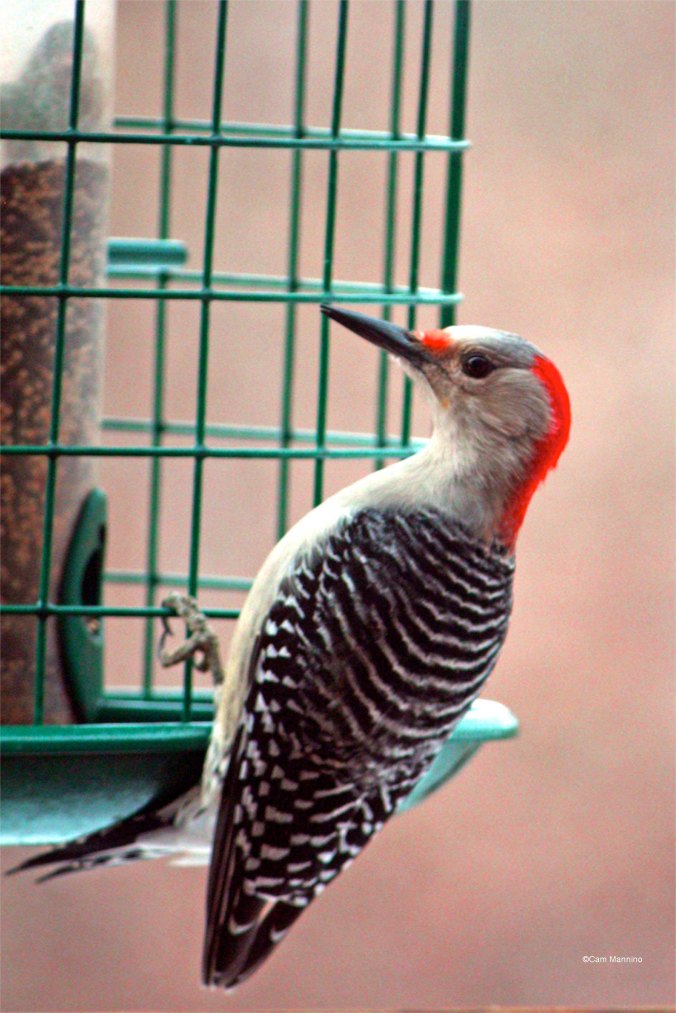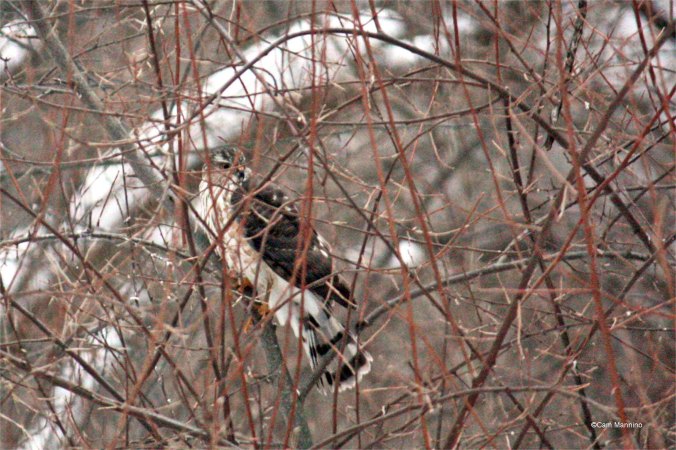This week Bear Creek again slipped from winter to fall and back again. The pond and marsh iced over and then melted in steady rain. The Eastern Old Field (above) glowed russet as the rain saturated every color in the park and the combination of wind and wet earth felled a large tree. And then heavy frost descended, edging everything in white. Over in the woods, raptors silently slipped through the branches searching for a meal, while smaller birds found places to hide. Mushrooms, lichens and mosses painted the forest with dabs of color, and deer stalked in the distance. A transition time at Bear Creek.
First, Some Safety Issues – and Practicalities
If you enter the park from Snell Road, you may see caution tape across the path leading into the park. A large tree has fallen into another on the trail and is in danger of falling across the path. I got a quick shot to satisfy the curiosity of park visitors, so please avoid the area until our trusty OT maintenance crew can remove the danger. Feel free to go west past the Playground Pond or north down the path behind the playground that runs to the Center Pond.
Edit: As of Saturday, December 5, the tree was removed and the path in from Snell Road is now open! Thanks again to the Maintenance Crew for getting this taken care of.

A large tree has fallen into another along the Snell Road entrance. Hence the caution tape that prevents entrance by that path until the maintenance crew can remove it.
And speaking of the maintenance crew, many thanks to Doug Caruso, OT Maintenance Foreman, for washing the slippery gray mud that had washed onto the deck at the Center Pond after the rain.  The deck looks better and feels safer underfoot!
The deck looks better and feels safer underfoot!
And speaking of cleaning things up, can I please urge Bear Creek visitors to use the Pet Waste stations this winter? The maintenance crew just installed a new one at the south end of the Eastern Path,  so if you forget your plastic bag, please pick one up there or at the Snell Parking lot and clean up after your dog. Dog waste on white snow is not a pretty sight, and pet waste spreads disease into our water and wildife! And remember that dog leashes keep both other dogs and other walkers safer and happier in the park. Thanks!
so if you forget your plastic bag, please pick one up there or at the Snell Parking lot and clean up after your dog. Dog waste on white snow is not a pretty sight, and pet waste spreads disease into our water and wildife! And remember that dog leashes keep both other dogs and other walkers safer and happier in the park. Thanks!
The Forest: Raptors Hunt and Smaller Birds Hide
When I walked into the woods near the marsh early last week, I heard the high, raw cry of a young Red-tailed Hawk (Buteo jamaicensis) and finally spotted it perched high in a tangle of branches near the water. It flew above the treetops from there, so here’s a photo of another young Red-Tailed Hawk on the hunt.

A young Red-tailed Hawk called and soared above the marsh. Young red-tails don’t have a red tail in their first year.
Nearby in the woods, a female Red-bellied Woodpecker (Melanerpes carolinus) moved nervously from tree to tree. When the hawk soared away, she quickly flew to a branch very close to one on which the hawk had perched. I thought that was odd until I saw her disappear into a hole on the bottom side of the branch. In a few seconds, her head peeked out as if she was checking to see if the coast was clear! Good hiding place, isn’t it?

A Red-bellied Woodpecker’s found a nice, safe hole on the underside of a dead branch near the marsh.
If you’re unfamiliar with the appearance of this female year ’round resident, here’s a closeup of a female Red-belly, like the one in the hole above. The red on the her head reaches only to the crown unlike the male on which the red feathers extend from the nape to the beak.

A closeup of a female Red-bellied Woodpecker like the one hiding in a hole in the tree in the photo above.
Later in the week, a small, blue-gray Sharp -shinned Hawk (Accipiter striatus) shot by me on the western side of the woods. As I’d crested a rise, this little woodland hawk, the smallest hawk in North America, had spotted me from a low limb, immediately leapt into the air and flew off with consummate skill among the tree limbs. Here’s a photo of one scoping out prey from a bush in a previous winter. Sharp-shinned hawks often pounce on mice and, unfortunately songbirds, from low branches. So I may have thwarted a hungry raptor, who like all birds was trying to bulk up for the winter months.
With these hungry raptors hunting around the woods, the American Tree Sparrow (Spizella arborea), which seems to be the only sparrow around right now, hid within the protective branches of a bush. Pretty effective camouflage.
A flock of American Crows (Corvus brachyrhynchos) could be heard in the distance, too. Crows frequently mob hawks, harassing them with dive-bombing and noise to drive them from their territories. This may have been just late fall group behavior (left), but I have seen hawks and crows in conflict before in Bear Creek (right). (Rest your cursor on the photos for captions.)
- A large flock of crows in the autumn at Bear Creek
- Crows harassing a hawk at Bear Creek
The woods provided a couple of other fun moments. A wary doe near Gunn Road stalked along behind the trees, but curiosity about the cameras always seems to seduce White-tailed Deer (Odocoileus virginianus). They just have to turn and look.
And one of the fun natural features of the park showed up nicely in the snow the week before last – what I call The Mitten Stone. I forgot to include it in last week’s blog. Now that’s Pure Michigan, isn’t it?
The Forest: Dabs of Color in the Brown-Gray Landscape
Mushrooms (the seeding parts of underground fungi), lichens and mosses did their part again this week to add bits of color here and there to the rather somber backdrop of late fall. I’m no mushroom expert so no specific identifications here. Does anyone know a reliable site? (Click on images to enlarge. Rest your cursor on a photo for a caption)
- A yellow shelf mushroom that had fallen from a tree. It seems to have released its spores.
- These mushrooms covered a stump near the marsh.
- These colorful shelf mushrooms edged a log on the Northern Loop.
- Several trees have bright green moss “toes” this time of year.
- Pink and green shelf mushroom on a snag (standing dead tree).
- Lichen (I think) makes a turquoise patch on this purplish mossy log.
I’m a firm believer that there’s no bad weather for walking, just bad clothing. Try a rainy walk at Bear Creek in a sturdy raincoat and good boots – or with an umbrella – and see how the moisture saturates the colors. Or let the frost prickle your nose on a super cold morning. A long walk or a short stroll, you’re bound to discover something worth the trip.
*Footnote: As well as Oakland Township Stewardship Manager, Dr. Ben VanderWeide, my sources for information are as follows: Ritland, D. B., & Brower, L. P. (1991);Stokes Nature Guides: A Guide to Bird Behavior Volumes 1-3, Allaboutbirds.org, the website of the Cornell Ornithology Lab at Cornell University; Wikipedia; http://www.butterfliesandmoths.org; Herbarium of the University of Michigan at michiganflora.net.; various Michigan Field Guides by Stan Tekiela; Butterflies of Michigan Field Guide by Jaret C. Daniels; University of Wisconsin's Bug Lady at www4.uwm.edu/fieldstation/naturalhistory/bugoftheweek/ for insect info http://www.migrationresearch.org/mbo/id/rbgr.html for migration info; invaluable wildflower identification from local expert, Maryann Whitman; experienced birder Ruth Glass, bird walk leader at Stoney Creek Metro Park for bird identification;Birds of North American Online; Audubon.org, Nature in Winter by Donald Stokes, Trees in My Forest by Bernd Heinrich, Winter World by Bernd Heinrich














